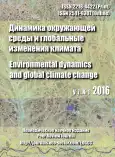Vol 7, No 1 (2016)
- Year: 2016
- Published: 15.06.2016
- Articles: 19
- URL: https://edgccjournal.org/EDGCC/issue/view/376
Articles
Trends of changing of algal groups in a series of trophic reduction of bog ecosystems (Plesetsk district Arkhangelsk region)
Abstract
 5-17
5-17


Some aspects of the use of diatoms in diagnostic of environment
Abstract
In the article the question of the possibility of using a unique group of diatoms in the diagnosis of environmental conditions.DiscussedcontroversialviewsontheconceptsofBacillariophytaasphytoliths.Forexample,literature data and own research presents diagnostic possibilities of diatoms: Marking soil formation processes, particularly the process of development of primary substrates, the geographical distribution of diatoms in soils. In particular, the features of the taxonomic composition of diatoms in bogs ecosystems, steppe, taiga and some others. The possibility of using diatoms as biological indicators of current conditions and the reconstruction of paleoecological environment. Includingspecial attention given to the possibilities of diagnostic spaleoecological conditions through modern representatives Bacillariophyta. However, there is still a lot of questions. It is important to accumulate data on the ecological spectrum of species of diatoms, especially environmental preferendum each of them to reliably diagnose the conditions of modern systems and reconstruct paleosoils conditions. What kind of phytocenotic indicators should be used to characterize the type (incidence, activity, ecol-cenotic significance) using the known formulas in the soil algology. To what extent correct this extrapolation? For now are dominated questions, but the prospects of this direction of research question remains.
 18-26
18-26


Phytoliths of species some genera of the family Cyperaceae
Abstract
 27-33
27-33


Paleosoil algoflora of pleistocene loess-soil series of Ob plateau
Abstract
 34-40
34-40


Phytoliths in soils of hemiboreal dark coniferous forest in southeast of West Siberia
Abstract
 41-53
41-53


The history of the phytolith investigations in Russia
Abstract
 63-67
63-67


Late holocene climate and vegetation changes around lake Malye Chany
Abstract
 68-75
68-75


The reconstruction of vegetation and conditions of soil formation using soils properties and microbiomorfological data
Abstract
 76-84
76-84


Conditions of microbiomorphic spectrum formation in steppe littoral catena of Northern Kulunda
Abstract
 85-92
85-92


Palynological method as a way of stratification of archeological objects: case study Os’kino Boloto
Abstract
 93-99
93-99


Palynological and radiocarbon data from late quaternary sediments of the dune massif - Tukulan Kysyl-syrskiy (Central Yakutia)
Abstract
 100-107
100-107


Macrofossils analysis of the peat to reconstruct holocene paleoecological conditions about Kansk forest-stepp zone (Yenisey Siberia)
Abstract
 108-115
108-115


Diagnosis of medieval-era ploughing using phytolith analysis by the example of archaeological sites Kuckarki and Knyazhich of Moscow region
Abstract
 116-131
116-131


Experience of application of miсrobiomorphic analisis for the Schurovsky burial and settlement (Moscow region, I millennium AD)
Abstract
 132-139
132-139


Phytoliths research archaeological site «Novoilinka-VI»
Abstract
 140-147
140-147


The soil phytoliths analysis of meadow and steppe phytocenoses in Altai region
Abstract
 148-154
148-154


Phytoliths in some grasses of Altai region from deferent ecological groups and life forms
Abstract
 155-162
155-162


Diet and environment reconstruction of Coelodonta antiquitatis in the late pleistocene by C-N isotope analyses of paleontological material (archeological complex Khotyk and Kamenka, west Transbaikalia)
Abstract
 163-169
163-169


Microbiomorph studies on the cultural layers of Jankent (AD X-XIII), Southern Kazakhstan
Abstract
 54-62
54-62











